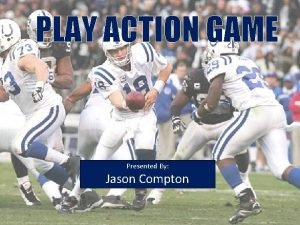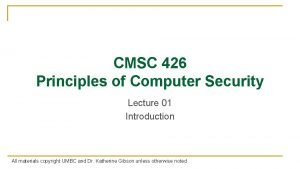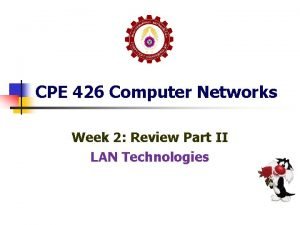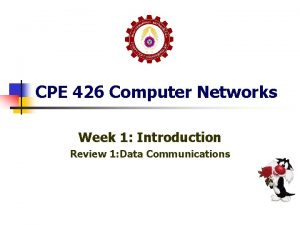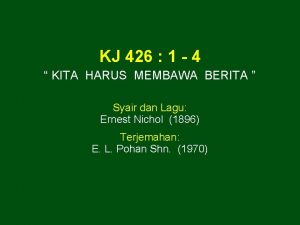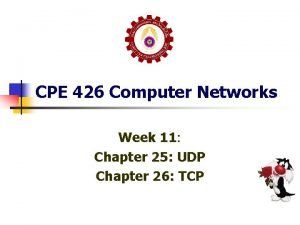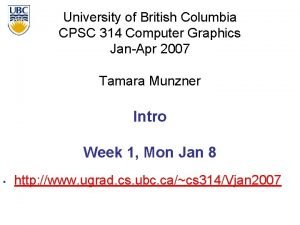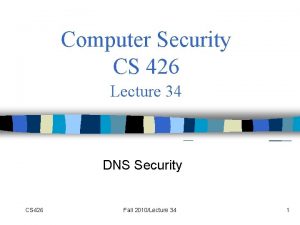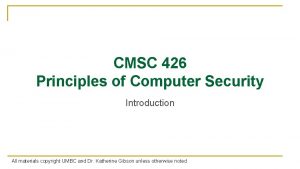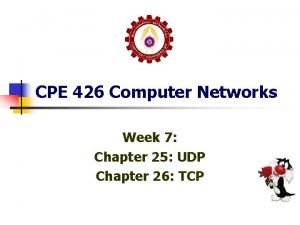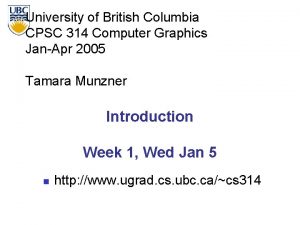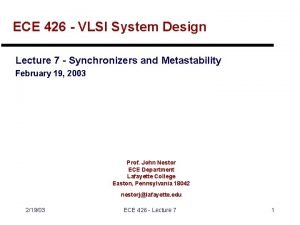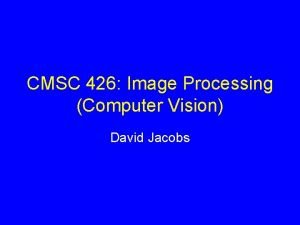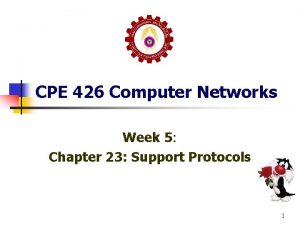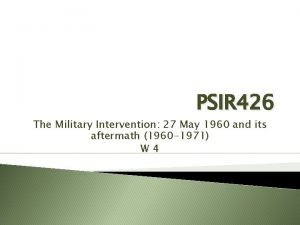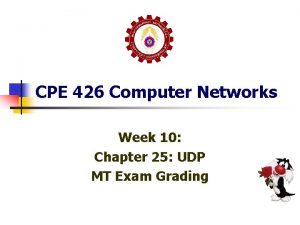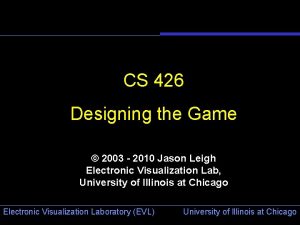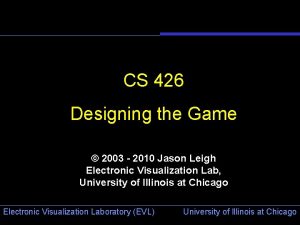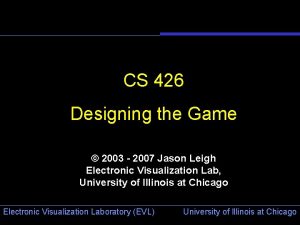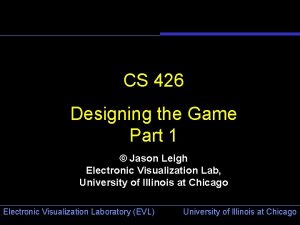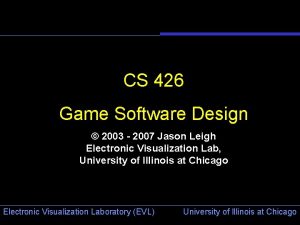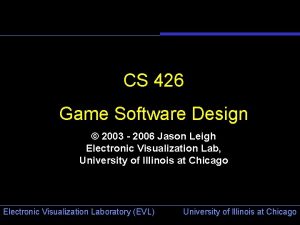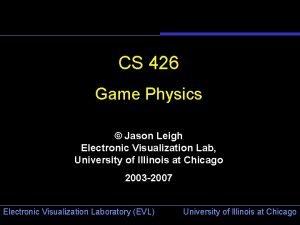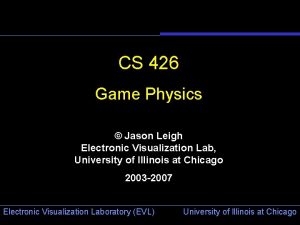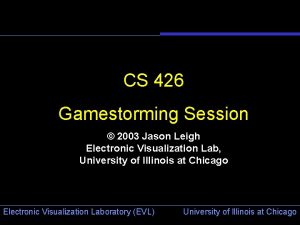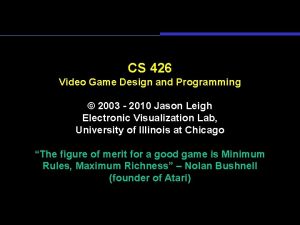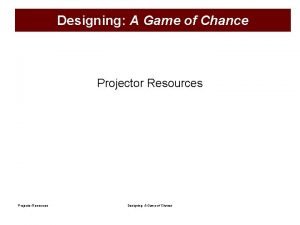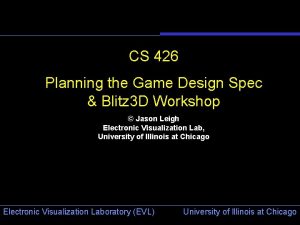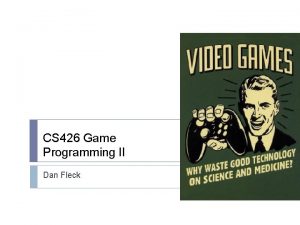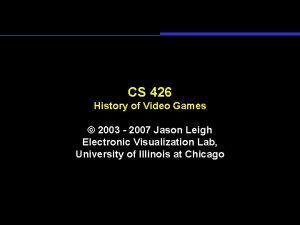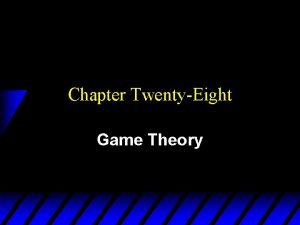CS 426 Designing the Game 2003 2011 Jason
















































- Slides: 48

CS 426 Designing the Game © 2003 - 2011 Jason Leigh Electronic Visualization Lab, University of Illinois at Chicago Electronic Visualization Laboratory (EVL) University of Illinois at Chicago

Gameplay • Gameplay is the degree and nature of the interactivity that the game includes- ie. How the player is able to interact with the game-world and how that game-world reacts to the choices the player makes. • In the game that you design, try to articulate its gameplay in a concise sentence and FOCUS on this goal throughout the development of the game. Electronic Visualization Laboratory (EVL) University of Illinois at Chicago

Lets Go Through A Few Game Genres and Ask… What is the FOCUS of the Game? What is the CORE GAME PLAY? Electronic Visualization Laboratory (EVL) University of Illinois at Chicago

Action (1 st and 3 rd person shooters) Halo – Bungie (2002) Psi-Ops (2004) Electronic Visualization Laboratory (EVL) DOOM – id (1994) Devil May Cry – Capcom (2001) University of Illinois at- 1981 Chicago Castle Wolfenstein

Adventure Prince of Persia – Ubisoft (2003) Tomb Raider – Eidos (1996) Mark of Kri – San Diego Studios (2002) Electronic Visualization Laboratory (EVL) Infocom Games - 1981 Adventureland – Scott Adams (1978) University of Illinois at Chicago

Stealth: A Sub-Genre of Adventure Chronicles of Riddick (2004) Electronic Metal Gear. Visualization Solid (1998) Laboratory (EVL) Thief: Dark Project (1999) Tenchu (1998) University of Illinois at Chicago

Fighters Mortal Kombat Deadly Alliance – Midway (2002) Virtua Fighter – Sega (1993) Karateka – Broderbund (1986) Mortal Kombat – Midway. Laboratory (1992) Electronic Visualization (EVL) University of Illinois at Chicago

Driving Wipeout – Psygnosis (1995) Grand Theft Auto 3 – Rockstar (2002) Carmageddon (1997) Electronic Visualization Laboratory (EVL) Pole Position – Atari (1982) University Illinois at Chicago Deathof. Race – Exidy (1976)

RPG Gameplay: Similar to adventure, less emphasis on action, more emphasis on statistical dice rolling to determine outcome Elderscrolls Oblivion – 2 K Games (2006) Gauntlet Dark Legacy – Midway (2002) Knights of the Old Republic – Bio. Ware (2003) Electronic Visualization Laboratory (EVL) Gauntlet - Midway (1985) Wizardry Sir-Tech (1979) University of –Illinois at Chicago

Space Simulations Gameplay: Fly through space and shoot things Become a privateer Darkstar One – Ascaron Ent. (2006) Privateer – Origin (1993) Mercenary – Novagen (1985) Rogue Squadron – Lucas. Arts (2001) Star Raiders – Doug Neubauer, Atari (1979) (8 K) Elite - Acornsoft (1984) Wing Commander Electronic Visualization Laboratory (EVL) – Chris Roberts, Origin (1990) University of Illinois at Chicago

Real Time Strategy (RTS) Gameplay: Build armies and battle Battle. Zone – Activision (1998) Archon – EOA (1983) Electronic Visualization Laboratory (EVL) Command Conquer – Westwood Studios (1995) Eastern Front 1941 – Chris Crawford, Atari (1981) University of Illinois at Chicago

Empire Building Master of Orion – Simtex (1994) Civilization – Sid Meier, Microprose (1991) MULE – Ozark Softscape (1983) Electronic Visualization Laboratory (EVL) University of Illinois at Chicago

Sports Madden NFL 07 – Electronic Arts (2006) Electronic Visualization Laboratory (EVL) FIFA 07 – Electronic Arts (2006) Olympic Decathlon – University of Microsoft Illinois at (1981) Chicago

How Do I Start? • Draw storyboards to sketch out your ideas. • And/Or Build a “toy” then grow the concept into a game. • E. g. : http: //balldroppings. com/js/ • Flesh out ideas using AGD Cards. • Build a rapid prototype of the game idea and iterate A LOT!!! Electronic Visualization Laboratory (EVL) University of Illinois at Chicago

Brainstorm the Gameplay (Using Storyboards) Electronic Visualization Laboratory (EVL) • Brainstorm the GAMEPLAY! • DO NOT start by brainstorming the opening cutscene of the game. • Draw them by HAND. NOT BY COMPUTER. • Do them FAST. • Let the IDEAS flow. • DO NOT JUDGE the Ideas University of Illinois at Chicago

Electronic Visualization Laboratory (EVL) University of Illinois at Chicago

Electronic Visualization Laboratory (EVL) University of Illinois at Chicago

Electronic Visualization Laboratory (EVL) University of Illinois at Chicago

Electronic Visualization Laboratory (EVL) University of Illinois at Chicago

Electronic Visualization Laboratory (EVL) University of Illinois at Chicago

Electronic Visualization Laboratory (EVL) University of Illinois at Chicago

Is there a more “theoretical” basis for why people play games and what they want? Electronic Visualization Laboratory (EVL) University of Illinois at Chicago

First lets consider what is meant by: FUN Electronic Visualization Laboratory (EVL) University of Illinois at Chicago

Funativity • 1980 Dr. Stephen Arnold - new manager of Lucasfilm Games (previously at Atari) - practicing child psychologist for years before that. • Steve’s question for any new game proposals: “What is the Funativity Quotient? ” • Ie: What elements of the game contributed to the feeling of fun, and to what degree was each part of the design important to that process. Electronic Visualization Laboratory (EVL) University of Illinois at Chicago

Natural Funativity • Tries to explain the Natural basis for FUN • Natural: ie based on Evolutionary concepts. For example: – Chris Crawford - Animals learn by playing, not going to school. – Marshall Mc. Luhan (Communictions theorist) - there is little difference between education and entertainment. – Christopher Wills - Animals play to practice basic survival skills, establish social dominance, learning to live with their peers. Electronic Visualization Laboratory (EVL) University of Illinois at Chicago

Consider our ancestors: • • We were/are hunters / gatherers - is it surprising that games like Halo & Pacman are so popular? After returning from a hunt, they can: 1. 2. 3. • • • Go back out again and hunt some more- the workaholic. Rest until your belly is empty again. Foraging - constructive “rest”. Use off-time to learn new things, to think about how to improve things for the next hunt- ie better strategies, better weapons. They can do this in safety and so there are benefits over going on the hunt without end. Similarly, video games allows us to learn/do things in a safe environmentmuch like martial arts today are a safe way to engage in historical battle. Without some kind of learning, an activity eventually becomes mundane. When people stop learning in a game, they stop playing it. The survival skills crucial to our ancestors, as well as hobbies & pastimes popular today, are good sources of inspiration for new game themes. Consider what skills and information the player learns over the course of your game, and emphasize skills important to the player’s survival in the game. Establishing a safe, familiar territory & then inviting players to explore its mysterious boundaries is a proven feature of many successful games. Electronic Visualization Laboratory (EVL) University of Illinois at Chicago

3 Categories of Natural Funativity • Physical Fun – Our strongest instinct: survival – We are hardwired to enjoy practicing physical activities that enhance our survival – We enjoy TV shows, books, news, about survival- e. g. police shows, doctors, etc. – Forms of physical fun based on survival: – Hunting: 1997 surprise big video game hit: Deer Hunter – Gathering: Shopping, Gambling, Beanie Babies, Pokemon, Pacman – Exploring places: e. g. traveling. There are inherent survival advantages of knowing where to find “good stuff” or to avoid dangerous places. Myst. – Tool Use: Build bigger better solutions / weapons etc. – Dancing: All cultures dance. It is a social survival skill. Dance Revolution. – Reproduction: activities like: meeting, attracting a mate. Multiplayer games facilitate social engagements. – Video games are about doing, not telling. Let the players control or initiate actions so they can learn physical skills instead of making them into a passive observer. Electronic Visualization Laboratory (EVL) University of Illinois at Chicago

3 Categories of Natural Funativity • Social Fun • Shopping, trading collectibles, team sports, storytelling (vital for survival as a means of sharing information) • Social fun manifests in several ways in games: – – Stories about places and people, stories told by people in the game Multiplayer games. Everquest, Ultima Online. Cooperative single-player games. Halo AIs (Artificially Intelligent characters) have been used to expand multiplayer games but once AIs are detected the player loses interest- because the challenge is in beating another player that is normally better than an AI. E. g. Jedi Outcast – Adding secrets, Easter eggs, tradable objects, or characters to games that players can share with friends adds social aspects that can extend gameplay opportunities. Electronic Visualization Laboratory (EVL) University of Illinois at Chicago

3 Categories of Natural Funativity • Mental Fun – Games that test our logical or patternmatching skills. Chess, Tetris, Rubic’s cube – How is pattern-matching useful in survival? Your entire visual system is a complex pattern matcher- over 2/3 of your brain is dedicated to visual image processing. – How is Tetris useful for Algebra? – v 2=u 2+2 as – KE=1/2 mv 2 – => KE=1/2 m (u 2+2 as) – Making underlying play patterns in games consistent & predictable makes them easier to learn, but adding new patterns as the game progresses keeps it fresh & fun. Electronic Visualization Laboratory (EVL) University of Illinois at Chicago

3 Categories of Natural Funativity • Many games have all 3 components: • Halo: physical mastering of game controller and weapons, navigating and exploring spaces, killing aliens, gathering weapons; multiplayer capable; devising tactics to use against aliens. • KOTOR: is an excellent example where to get thru a phase of the game you could either fight, or solve a puzzle. • Deconstruct your game idea… Electronic Visualization Laboratory (EVL) University of Illinois at Chicago

Basic Elements of a Modern Video Game 1. 2. 3. Developer & publisher logo screens Opening animation / cutscene to provide context Game configuration screen – – – 4. Level or Game prep screen and/or cutscene – 5. 6. 7. 8. 9. 10. Select control layout Built-in tutorial Game type – single or multiplayer Cheats Extras – unlockable gems Credits Select attributes of your “character”- choose a person or a spaceship. The Game level (save here) The end-of-level cutscene Save game here Repeat from 4. End of game cutscene. Credits Elaborate on this Electronic Visualization Laboratory (EVL) University of Illinois at Chicago

Classic Game Structure • Convexity is the notion that one option or choice expands into many and then back to one again. • A game designer applies convexity structure by creating choices that continuously diverge and later converge at "crisis points". • Role-Playing Games are an excellent example. • Chess is another example. • • Gives the player the sense that choices are available and yet makes the game tractable for developers. Ie it is not infinitely open-ended. Change the story, setting, or interface if necessary to make limitations in a set of choices invisible. Give players alternatives to tough challenges that let them improve their skills or gather new resources to avoid frustrating bottlenecks. E. g. KOTOR had several solutions to a problem. Electronic Visualization Laboratory (EVL) University of Illinois at Chicago

A Series of Convexities Episodes or Chapters gives the player a sense of accomplishment And allows them to save the game Allows game to adjust difficulty level and to train players to handle greater difficulty Incorporate more choices as players become accustomed to using them In long RPGs players can sense the end of the game coming & become more impatient. Start reducing size of convexities toward the end. Electronic Visualization Laboratory (EVL) University of Illinois at Chicago

Flow • A series of convexities provides a good place to gradually increase difficulty. • According to Natural Funativity- mastering those challenges is at the heart of a good game. • But how do we introduce increasing difficulty? Electronic Visualization Laboratory (EVL) University of Illinois at Chicago

Flow • Mihaly Csikszentmihalyi (psychologist at U of Chicago) - Flow, The Psychology of Optimal Experience. • Flow refers to a kind of optimal experience, which is simultaneously demanding and rewarding. • E. g. musicians lost in their music; programmers composing code; athletes who are “in the zone”; gamers playing for hours. Electronic Visualization Laboratory (EVL) University of Illinois at Chicago

Dr. C suggests The Flow Channel - the path between 2 extremes of difficulty Too Hard (Becomes Frustrating to player) Increasing Difficulty on e m a G culty i f f i D ssi e r g ro P Too Easy (Becomes Boring to player) Increasing Time (and Player Skill) Electronic Visualization Laboratory (EVL) University of Illinois at Chicago

An even better way to introduce difficulty is as follows… Too Hard (Becomes Frustrating to player) Increasing Difficulty on i s s ogre lty r P lty difficu u c i f in Dif s e n m o Ga variati l a Ide vide Pro Too Easy (Becomes Boring to player) Increasing Time (and Player Skill) Electronic Visualization Laboratory (EVL) University of Illinois at Chicago

Mapping Flow to Convexities Place increasingly difficult at each convexity Relax and vary difficulty In-between convexities but still with a general trend toward Increasing difficulty Electronic Visualization Laboratory (EVL) University of Illinois at Chicago

Project Management Electronic Visualization Laboratory (EVL) University of Illinois at Chicago

Project Management 101 • You depend on each other for the overall success of the team. • You are here to all work 110% because frankly that should be your philosophy in everything you do. • There is too much mediocrity in the world why contribute to it? • “I am taking too many classes” is NOT a valid excuse. You are all adults / seniors / juniors / graduate students. • In life the only time positive things happen to you is if you do something well. Even there are ways to do things better- so start with the best you can and always try to do better. Electronic Visualization Laboratory (EVL) University of Illinois at Chicago

Project Management 101 • When discussing issues: – Give everyone a chance to explain their decisions. – Provide criticism on the work, NOT the person. – Provide constructive but mindful ideas of how to improve something. E. g. “have you thought about trying X? The reason is, if you try X…. ” – Never take criticism personally. – No Whining- just get it done- ie are you an Ameri. CAN or an Ameri. CANT? • Everyone is busy - Always respect everyone’s time. So: – Be on time at meetings. If you are late for a meeting you inconvenience others. It shows lack of respect for other people’s time. My schedule does not revolve around yours. – If you have to be late due to something you cannot control, call someone at the meeting. – Set an agenda for the meeting well before the meeting. – After a meeting write down a list of resolutions / tasks / directives for each person. If someone comes away from a meeting with nothing to do- something is very wrong. Electronic Visualization Laboratory (EVL) University of Illinois at Chicago

Project Management 101 • Set goals, create a timeline, assign responsibilities. • See: OPPM (One Page Project Management) • I am going to evaluate individual team members using this chart and a end-ofsemester evaluation form. Electronic Visualization Laboratory (EVL) University of Illinois at Chicago

Project Management 101 • Note any special dates like family travel / religious holidays etc on the timeline so your colleagues know well in advance that you will be tied up. • Exchange cell phone, email, IM addresses. • Use the HD video conference equipment in ICL. • Create backups of your work on multiple computers / media. Backup includes your web site. • Integrate parts of your game as often as possible- preferably weekly. DO NOT WAIT TILL THE END TO INTEGRATE. • Keeping a constantly working version provides visible progress & therefore encouragement. • Test this game on your friends for feedback. Write down the feedback and save it for your web site. Electronic Visualization Laboratory (EVL) University of Illinois at Chicago

Responsibility of the Project Manager • • • • Schedule weekly meetings. Collect and distribute all contact information. Make sure there is an agenda at every meeting. Make sure the agenda is followed. Make sure backup versions are being made. Make sure the team rehearses their demos. Check on status of deliverables at each meeting. Listen to your team members, NOT dictate- you haven’t earned that right. The only thing the manager can dictate is what I recommend- only because I have more experience. Make sure there action items after each meeting. Make sure the overall game is developed on time- that the game development team is not stuck in a technical problem they can’t solve. Manager needs to know when to cut their losses and come up with a backup plan. Make sure the web page is well designed and documented- provides a professional image of the company. Electronic Visualization Laboratory (EVL) University of Illinois at Chicago

Responsibility of the Team Members • • Attend all meetings. Be active in all meetings. Provide deliverables on time. Be communicative / responsive to email & make your team mates constantly aware of your development status. Show new progress at EVERY team meeting- with a short mini-demo. Again: if you have nothing to show it usually means you haven’t done anything. Voice technical and schedule concerns to managerremember the Space Shuttle disaster? Subtle way to tell someone they are not pulling their own weight: “Dude, you’re clearly overloaded, why don’t I work on that instead. ” Electronic Visualization Laboratory (EVL) University of Illinois at Chicago

Cultural Differences: Artists vs Computer Scientists • • • Artists don’t know and care (rightfully so) why something is not possible, or how difficult something is to do. CS people are sometimes over constrained by what they think they can do. CS people tend to like certain things solely on its technical merits rather than whether something fits in the overall vision of things. I. e. don’t see the forest for the trees. Artists understand the concept of showtime- i. e. getting something finished to a point that is presentable. CS people tend to tinker forever – “just-one-more-feature-itis”. Artists are experienced in taking and giving feedback through a process of critiquing. CS people take it personally when you don’t like their work. There are fine artists and graphic artists. Good art doesn’t necessarily translate to good communication. Graphic artists are generally better at balancing the two. Artists tend to be more “obsessed” with creating their own identity in the art world. Artists tend to think of CS people as their computer support. CS people tend to think Artists are “dumb”. CS needs to build a test harness or basic game environment for artists to test out their artwork in parallel while you are developing new code. Electronic Visualization Laboratory (EVL) University of Illinois at Chicago

(Agile) Game Development Cycle • • • Identify a small handful of top priority features/capabilities Design and implement the features Test the individual features Integrate features Test integrated system so far Repeat for next set of features For the class the recommended cycle time is 2 weeks MAX. But you should have WEEKLY working BUILDS. If a feature is late chances are you will never catch-up, so cut your losses and determine what you can cut from the game. • POLISHING CAN TAKE A LOT MORE EFFORT THAN CREATION. Electronic Visualization Laboratory (EVL) University of Illinois at Chicago

Development Tip: Issue Tracking Electronic Visualization Laboratory (EVL) University of Illinois at Chicago
 Jason game theory
Jason game theory Cmsc 426 umbc
Cmsc 426 umbc Cpe 426
Cpe 426 6974-6459-0121-7236-303
6974-6459-0121-7236-303 Psir 426
Psir 426 Cpe 426
Cpe 426 Kj 426
Kj 426 Explain why 186 426 is divisible by both 3 and 9
Explain why 186 426 is divisible by both 3 and 9 Sıcak tütme safhası
Sıcak tütme safhası Cpe 426
Cpe 426 Cpsc 426
Cpsc 426 Psir 426
Psir 426 Cs 426 purdue
Cs 426 purdue Cmsc 426 umbc
Cmsc 426 umbc Cpe 426
Cpe 426 Psir 426
Psir 426 Psir 426
Psir 426 Cmsc 426
Cmsc 426 Ubc cpsc 314
Ubc cpsc 314 Psir 426
Psir 426 Ece 426
Ece 426 Cmsc 426 umd
Cmsc 426 umd Cpe426
Cpe426 Psir 426
Psir 426 Cpe426
Cpe426 Psir 426
Psir 426 Cos 426
Cos 426 Môn thể thao bắt đầu bằng từ chạy
Môn thể thao bắt đầu bằng từ chạy Sự nuôi và dạy con của hươu
Sự nuôi và dạy con của hươu điện thế nghỉ
điện thế nghỉ Nguyên nhân của sự mỏi cơ sinh 8
Nguyên nhân của sự mỏi cơ sinh 8 Trời xanh đây là của chúng ta thể thơ
Trời xanh đây là của chúng ta thể thơ Gấu đi như thế nào
Gấu đi như thế nào Lp html
Lp html Thiếu nhi thế giới liên hoan
Thiếu nhi thế giới liên hoan Số nguyên tố là số gì
Số nguyên tố là số gì Vẽ hình chiếu vuông góc của vật thể sau
Vẽ hình chiếu vuông góc của vật thể sau Một số thể thơ truyền thống
Một số thể thơ truyền thống Các châu lục và đại dương trên thế giới
Các châu lục và đại dương trên thế giới Thế nào là hệ số cao nhất
Thế nào là hệ số cao nhất Sơ đồ cơ thể người
Sơ đồ cơ thể người Tư thế ngồi viết
Tư thế ngồi viết đặc điểm cơ thể của người tối cổ
đặc điểm cơ thể của người tối cổ Cách giải mật thư tọa độ
Cách giải mật thư tọa độ Chụp phim tư thế worms-breton
Chụp phim tư thế worms-breton Bổ thể
Bổ thể ưu thế lai là gì
ưu thế lai là gì Thẻ vin
Thẻ vin Bàn tay mà dây bẩn
Bàn tay mà dây bẩn
